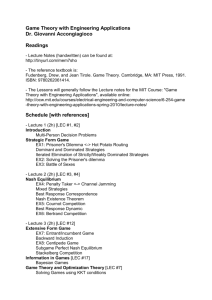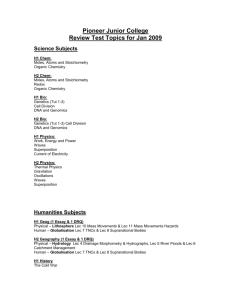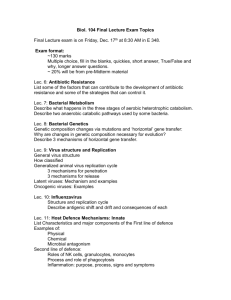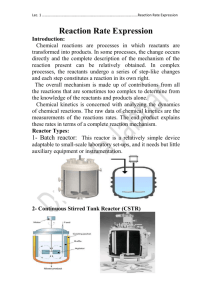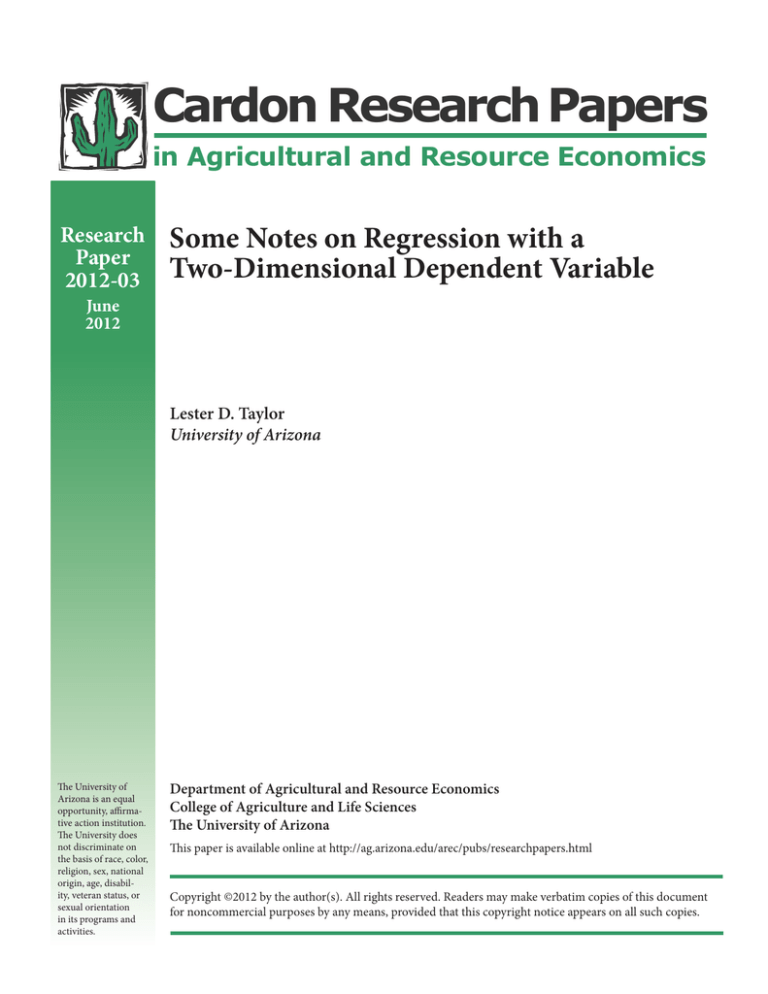
Cardon Research Papers
in Agricultural and Resource Economics
Research
Paper
2012-03
Some Notes on Regression with a
Two-Dimensional Dependent Variable
June
2012
Lester D. Taylor
University of Arizona
The University of
Arizona is an equal
opportunity, affirmative action institution.
The University does
not discriminate on
the basis of race, color,
religion, sex, national
origin, age, disability, veteran status, or
sexual orientation
in its programs and
activities.
Department of Agricultural and Resource Economics
College of Agriculture and Life Sciences
The University of Arizona
This paper is available online at http://ag.arizona.edu/arec/pubs/researchpapers.html
Copyright ©2012 by the author(s). All rights reserved. Readers may make verbatim copies of this document
for noncommercial purposes by any means, provided that this copyright notice appears on all such copies.
April 2012
Some Notes on Regression With
A Two-Dimensional Dependent Variable
Lester D. Taylor*
Department of Economics
Department of Agricultural & Resource Economics
University of Arizona
ltaylor@email.arizona.edu
Abstract
The purpose of these notes is to suggest procedures for dealing with dependent
variables in regression models that can be represented as points in the plane. The
“trick”, if it should be seen as such, is to represent dependent variables in polar
coordinates, in which case two-equation models can be specified in which estimation
proceeds in terms of functions involving cosines, sines, and radius-vectors.
Situations for which this procedure is relevant include analyses of markets in which
there are duopoly suppliers. The approach allows for generalization to higher
dimensions, and, perhaps most interestingly, can be applied in circumstances in
which values of the dependent variable can be points in the complex plane. The
procedures are illustrated using cross-sectional data on household toll-calling from
a PNR & Associates BILL HARVESTING survey of the mid-1990s and data from the
BLS Survey of Consumer Expenditures for the fourth quarter of 1999.
*
Paper presented at “The Road Ahead, Conference in Honor of Professor Emeritus
Lester D. Taylor,” Jackson Hole, WY, October 9-10, 2011. Forthcoming in volume of papers
from that conference to be published by Springer-Verlag.
2
Some Notes on Regression with
A Two-Dimensional Dependent Variable
Lester D. Taylor
University of Arizona
I. INTRODUCTION
The focus in this paper is on how one might estimate a model in which the dependent
variable is a point in the plane rather than a point on the real line. A situation that comes to mind
is a market in which there are just two suppliers and the desire is to estimate the market shares of
the two. An example would be determination of the respective shares of AT&T and MCI in the
early days of competition in the long-distance telephone market. The standard approach in this
situation (when such would have still been relevant) would be to specify a two-equation model, in
which one equation explains calling activity in the aggregate long-distance market and a second
equation that determines the two carriers’ relative shares. An equation for aggregate residential
calling activity might, for example, relate total long-distance minutes to aggregate household
income, a measure of market size, and an index of long-distance prices, while the allocation equation
might then specify MCI’s share of total minutes as a function of MCI’s average price per minute
relative to the same for AT&T, plus other quantities thought to be important.
The purpose of these notes is to suggest an approach that can be applied in situations of this
type in which the variable to be explained is defined in terms of polar coordinates on a twodimensional plane. Again, two equations will be involved, but the approach allows for
generalization to higher dimensions, and, even more interestingly, can be applied in circumstances
in which the quantity to be explained represents the logarithm of a negative number. The latter, as
will be seen, involves regression in the complex plane.
II. REGRESSION IN POLAR COORDINATES
To fix ideas, let us assume that we have two firms selling in the same market, with sales of
y1 and y2, respectively. Total sales will then be given by y = y1 + y2. The situation can be depicted,
as in Figure 1, as the vector (y1, y2) in the y1y2 plane, with y1 and y2 measured along their respective
axes. In polar coordinates, the point (y1, y2) can be expressed as:
(1)
y1 = r cosθ
(2)
y 2 = r sin θ ,
where
(3)
r = ( y12 + y 22 ) 1/ 2
3
and θ is the angle formed by r and y1. From (1) and (2), we see that:
Figure 1
y2
y1
(4)
cosθ =
y1
( y12 + y 22 ) 1/ 2
(5)
sin θ =
y2
.
( y + y 22 ) 1/ 2
2
1
We can now specify a two-equation model for determining y1, y2, and y in terms of cos θ and
r (or equivalently in sin θ and r):
(6)
cos θ = f(X, ε)
and
(7)
r = g(Z, η),
for some functions f and g, X and Z relevant predictors, and ε and η unobserved error terms.
At this point, the two-equation model in expressions (6) and (7) differs from the standard
approach in that the market “budget constraint” (y = y1 + y2) is not estimated directly, but rather
indirectly through the equation for the radius vector r. This being the case, one can legitimately ask,
why take the trouble to work with polar coordinates? The answer is that this framework easily
allows for the analysis of a market with three sellers, and can probably be extended to markets in
which n firms for n $4 compete. Adding a third supplier to the market, with sales equal to y3, the
polar coordinates for the point (y1, y2, y3) in 3-space will be given by:
(8)
y1 = r cos α
4
(9)
y2 = r cos β
(10)
y3 = r cos γ
(11)
r = ( y12 + y 22 + y 32 ) 1/ 2 ,
where cos α, cos β, and cos γ are the direction cosines associated with (y1, y2, y3) (now viewed as
a vector from the origin). From expressions (8) - (10), we then have:
(12)
(13)
(14)
y1
( y + y + y 32 ) 1/ 2
y2
cos β = 2
( y1 + y 22 + y 32 ) 1/ 2
y3
cos γ = 2
( y1 + y 22 + y 32 ) 1/ 2
cosα =
2
1
2
2
.
A three-equation model for estimating the sales vector (y1, y2, y3) can then be obtained by specifying
explanatory equations for r in expression (11) and for any two of the cosine expressions in (12) (14).
III. REGRESSION IN THE COMPLEX PLANE
An alternative way of expressing a two-dimensional variable (y1, y2) is as
(14)
z = y1 + iy 2
in the complex plane, where y1 and y2 are real and i = − 1 . The question that is now explored is
whether there is any way of dealing with complex variables in a regression model. The answer
appears to be yes, but before showing this to be the case, let me describe the circumstance that
motivated the question to begin with. As is well-known, the double-logarithmic function has long
been a workhorse in empirical econometrics, especially in applied demand analysis. However, a
serious drawback of the double-logarithmic function is that it cannot accommodate variables that
take on negative values, for the simple reason that the logarithm of a negative number is not defined
as a real number, but rather as a complex number. Thus, if a way can be found for regression
models to accommodate complex numbers, logarithms of negative numbers could be accommodated
as well.
The place to begin, obviously, is with the derivation of the logarithm of a negative number.
To this end, let v be a positive number, so that -v is negative. The question, then, is what is ln(-v),
which we can write as
5
(15)
ln(-v) = ln(-1Cv)
= ln(-1) + ln(v),
which means that problem becomes to find an expression for ln(-1). However, from the famous
equation of Euler,1
e iπ + 1 = 0 ,
(16)
we have, after rearranging and taking logarithms,
(17)
ln(-1) = iπ.
Consequently,
(18)
ln(-v) = iπ + ln(v).
To proceed, we now write ln(-v) as the complex number,
(19)
z = ln(v) + iπ,
so that (in polar coordinates; see Figure 2):
(20)
ln(v) = r cos θ
(21)
π = ir sin θ ,
where r, which represents the “length” of z -- obtained by multiplying z by its complex conjugate,
ln(v) -- iπ -- is equal to
r = [π2 + (ln(v)2)]1/2 .
(22)
This is the important expression for the issue in question.
To apply this result, suppose that we have sample of N observations on variables y and x that
we assume are related according to
(23)
f(y, x) = 0,
1
See Nahin (1998, p. 67).
6
Figure 2
Logarithm of Negative Number
3.5
3
2.5
i
2
1.5
1
0.5
0
0
2
4
6
8
10
12
ln(v), v negative
for some function f. Assume that both y and x have values that are negative, as well as positive, and
suppose that (for whatever reason) we feel that f should be double-logarithmic, that is, we posit:
(24)
ln(yi) = α + βln(xi) + εi ,
i = 1, ..., N.
From the foregoing, the model to be estimated can then be written as:
(25)
zi = α + βwi + εi ,
where:
ln(y)
(26)
z
if y > 0
=
[π2 + (ln(-y)2]½
if y < 0
and
ln(x)
(27)
w
if x > 0
=
[π2 + (ln(-x)2]½
if x < 0.
IV. AN EXAMPLE
In the Third Edition of Consumer Demand in The United States, the structure and stability
of consumption expenditures in the U. S. was undertaken using a principal-component analysis of
14 exhaustive categories of consumption expenditure using 16 quarters of data for 1996-99 from the
7
quarterly Consumer Expenditure Surveys conducted by the Bureau of Labor Statistics.1 Among
other things, the first two principal components (i.e., those associated with the two largest latent
roots) were found to account for about 85 percent of the variation in total consumption expenditures
across households in the samples. Without going into details, one of the things pursued in the
analysis was an attempt to explain these two principal components, in linear regressions, as
functions of total expenditure and an array of socio-demographical predictors such as family size,
age, and education. The estimated equations for these two principal components using data from
the fourth quarter of 1999 are given in Table 1.2 For comparison, estimates from an equation for the
first principal component in which the dependent variable and total expenditure are expressed in
logarithms are presented as well. As is evident, the double-log specification gives the better results.
Any idea, however, of estimating a double-logarithmic equation for the second principal component
was thwarted by the fact that about 10 percent of its values are negative.
The results from applying the procedure described above to the principal component just
referred to are given in Table 2. As mentioned, the underlying data are from the BLS Consumer
Expenditure Survey for the fourth quarter of 1999, and consist of a sample of 5649 U. S. households.
The dependent variable in the model estimated was prepared according to expression (26), with the
logarithm of y, for y < 0, calculated for the absolute value of y. The dependent variable is therefore
z = ln(y) for the observations for which y is positive and [π2 + ln(-y)2]1/2 for the observations for
which y is negative. All values of total expenditure are positive and accordingly require no special
treatment.
From Table 2, we see that, not only is total expenditure an extremely important predictor,
but also that the R2 of the logarithmic equation is considerably higher than the R2 for the linear
model in in Table 1: 0.5204 vs. 0.0598. However, as the dependent variable in logarithmic equation
is obviously measured in different units than the dependent variable in the linear equation, a more
meaningful comparison is to compute an R2 for this equation with the predicted values in original
(i.e., arithmetic) units. To do this, we define two dummy variables:
1 if y < 0
δ1 =
(28)
0 if y > 0
1 if y > 0
(29)
δ2 =
-1 if y < 0 ,
and then:
1
See Taylor and Houthakker (2010, Chapter 5).
2
Households with after-tax income less than $5000 are excluded from the analysis.
8
(30)
p =
( z$ 2 − δ1π 2 ) 1/ 2 .
Table 1
Principal Component Regressions
BLS Consumer Expenditure Survey
1999 Q4
Variable
PC1 linear
Estimated
Coefficient t-value
intercept
totexp
NO_EARNR
AGE_REF
FAM_SIZE
dsinglehh
drural
dnochild
dchild1
dchild4
ded10
dedless12
ded12
dsomecoll
ded15
dgradschool
dnortheast
dmidwest
dsouth
dwhite
dblack
dmale
dfdstmps
d4
123.89
0.48
-108.59
-5.27
-37.14
177.78
77.15
40.45
303.05
-63.40
-6.50
183.89
39.82
-4.09
-279.17
-358.85
-63.66
-91.50
-26.85
-202.39
8.01
-39.06
138.25
-12.15
0.34
209.39
-5.28
-4.67
-1.90
3.48
1.32
0.77
4.28
-0.81
-0.08
0.53
0.12
-0.01
-0.80
-1.02
-1.24
-1.92
-0.60
-2.64
-0.09
-1.13
1.55
-0.20
PC2 linear
Estimated
Coefficient t-value
936.53
-0.08
64.41
6.46
43.88
-297.13
-549.14
-299.72
143.66
479.38
92.49
-207.06
288.75
292.48
1419.24
2022.19
96.39
-266.89
-424.42
208.95
129.24
59.61
-525.22
141.63
R2 = 0.9052
PC1 double-log
Estimated
Coefficient t-value
0.94
-14.04
1.03
2.10
0.83
-2.14
-3.47
-2.10
0.75
2.25
0.40
-0.22
0.31
0.31
1.50
2.12
0.69
-2.06
-3.51
1.00
0.52
0.64
-2.17
0.87
R2 = 0.0598
-1.5521
1.0723
-0.0088
-0.0007
-0.0060
0.0527
-0.0140
-0.0220
0.0612
-0.0021
-0.0022
0.1193
0.1000
0.0810
0.0727
0.0675
-0.0232
-0.0395
-0.0266
-0.0328
0.0107
-0.0088
0.0439
0.0076
-20.85
215.23
-2.20
-3.52
-1.80
5.95
-1.41
-2.46
5.06
-0.16
-0.15
2.01
1.69
1.37
1.22
1.13
-2.65
-4.85
-3.49
-2.51
0.69
-1.50
2.86
0.74
R2 = 0.9309
A predicted value in arithmetic units, p$ follows from multiplying the exponential of p by δ2:
p$ = δ2ep.
(31)
An R2 in arithmetic units can now be obtained from the simple regression of y on p$ :3
y$ = -587.30 + 1.3105 p$
(32)
(-19.39)
3
R2 = 0.6714.
(107.42)
t-ratios are in parentheses. All calculations are done in SAS.
9
Thus, we see that when R2s are calculated in comparable units, the value of 0.0598 of the linear
model is a rather pale shadow of the value of 0.6714 of the “double-logarithmic” model.
Table 2
Double-Logarithmic Estimation
Of Second Principal Component
Using Expression (26)
Variable
intercept
lntotexp
NO_EARNR
AGE_REF
FAM_SIZE
dsinglehh
drural
dnochild
dchild1
dchild4
ded10
dedless12
ded12
dsomecoll
ded15
dgradschool
dnortheast
dmidwest
dsouth
dwhite
dblack
dmale
dfdstmps
d4
Estimated
Coefficient
-3.1450
1.2045
-0.1161
-0.0014
-0.0017
0.2594
-0.1269
-0.0294
0.2519
0.1586
0.0410
-0.0839
-0.2072
-0.2101
-0.2290
-0.1416
0.0522
0.0084
-0.0118
-0.0117
0.1248
-0.0693
0.2198
-0.0266
t-value
-11.54
66.03
-7.97
-1.92
-0.14
8.00
-3.48
-0.89
5.69
3.24
0.76
-0.39
-0.96
-0.97
-1.05
-0.65
1.63
0.28
-0.42
-0.24
2.18
-3.21
3.91
-0.71
R2 = 0.5204
However, before concluding that the non-linear model is really much better than the linear
model, it must be noted that the double-log model contains information that the linear model does
not, namely, that certain of the observations on the dependent variable take on negative values.
Formally, this can be viewed as an econometric exercise in “switching regimes”, in which (again,
for whatever reason) one regime gives rise to positive values for the dependent variable while a
second regime provides for negative values. Consequently, a more appropriate test of the linear
model vis-a-vis the double-logarithmic one would be to include such a “regime change” in its
estimation. The standard way of this doing this would be to re-estimate the linear model with all
the independent variables interacted with the dummy variable defined in expression (29). However,
a much easier, cleaner, and essentially equivalent procedure is to estimate the model as follows:
(33)
y = a0 + a1δ1 + (b0 + b1δ1) y$ p + ε ,
10
where y$ p is the predicted value of y in the original linear model and δ1 is the dummy variable
defined in expression (28). The resulting equation is:
y$ = 2407.26 - 8813.13δ1 - (0.5952 - 4.7517δ1) y$ p
(34)
(43.47)
(-109.94)
(-14.41)
R2 = 0.5728.
(51.39)
However, “fairness” now requires that we do a comparable estimation for the non-linear model:
y$ = 315.41 - 80.88δ1 + (1.7235 + 0.88786δ1) p$
(35)
(11.04)
(-0.90)
(52.58)
R2 = 0.8085.
(75.95)
As heads may be starting to swim at this point, it will be useful to spell out exactly what has
been found:
(1).
To begin with, we have a quantity, y, that can take negative as well
as positive values, whose relationship with another variable we have
reason to think may be logarithmic.
(2).
As the logarithm of a negative number is a complex number, the
model is estimated with a “logarithmic” dependent variable as
defined in expression (26). The results, for the example considered,
show that the non-linear model provides a much better fit (as
measured by the R2 between the actual and predicted values measured
in arithmetic units) than the linear model.
(3).
Since the non-linear model treats negative values of the dependent
variable differently than positive values, the non-linear model can
accordingly be viewed as allowing for “regime change”. When this
is allowed for in the linear model (by allowing negative and positive
y to have different structures), the fit of the linear model [per
equation (34)] is greatly improved. However, the same is also seen
to be true [cf., equation (35)] for the non-linear model.
(4).
The conclusion, accordingly, is that, for the data in this example, a
non-linear model allowing for logarithms of negative numbers gives
better results than a linear model: an R2 of 0.81 vs. 0.58 [from
equations (34) and (35)].
On the other hand, there is still some work to be done, for the fact that knowledge that
negative values of the variable being explained are to be treated differently as arising from a
different “regime” means that a model for explaining “regime” needs to be specified as well. Since
“positive-negative” is clearly of a “yes-no” variety, we can view this as a need to specify a model
11
for explaining the dummy variable δ1 in expression (28). As an illustration (but no more than that),
results from the estimation of a simple linear “discriminant” function, with δ1 as the dependent
variable and the predictors from the original models (total expenditure, age, family, education, etc.)
as independent variables, are given in equation (36):4
δ$1
(36)
= 0.0725 + 0.00001473totexp + other variables
(0.83)
(27.04)
R2 = 0.1265.
V. ADDITIONAL EXAMPLE
A second example of the framework described in Section II will now be presented using data
from the BILL HARVESTING II Survey that was conducted by PNR & Associates in the mid1990s. Among other things, information in this survey was collected on households that made longdistance toll calls (both intra-lata and inter-lata) using both their local exchange carrier and another
long-distance company.5 While data from that era is obviously ancient history in relation to the
questions and problems of today’s information environment, they nevertheless provide a useful data
set for illustrating the analysis of markets in which households face twin suppliers of a service.
For notation, let v and w denote toll minutes carried by the local exchange company (LEC)
and long-distance carrier (OC), respectively, at prices plec and poc. In view of expressions (6) and (7)
in Section II, the models for both intra-lata and inter-lata toll calling will be assumed as follows:
(37)
cosθ = a + b income + c (plec/poc) + socio-demographical variables + e
(38)
r = α + β income + γ plec + λpoc + socio-demographical variables + ε ,
where:
cosθ =
(39)
(40)
z =
v
r
(v 2 + w 2 ) 1/ 2 .
The estimated equations for intra-lata and inter-lata toll calling are tabulated in Tables 3 and
4. As the concern with the exercise is primarily with procedure, only a few remarks are in order
4
Interestingly, a much improved fit is obtained in a model with total expenditure and the
thirteen other principal components (which, by construction, are orthogonal to the principal
component that is being explained) as predictors. The R2 of this model is 0.46.
5
Other studies involving the analysis of these data include Taylor and Rappoport (1997)
and Kridel, Rappoport, and Taylor (2002).
12
about the results as such. In the “shares” equations (i.e., with cosθ as the dependent variable), the
relative price is the most important predictor (as is to be expected), while income is of little
consequence. In the “aggregate” equations (i.e., with z as the dependent variable), of the two prices,
the LEC price is the more important for intra-lata calling and the OC price for inter-lata. Once
again, income is of little consequence in either market. R2s, though modest, are respectable for
cross-sectional data. For comparison, models are also estimated in which the dependent variables
are the ratio (v/w) and sum (v + w) of LEC and OC minutes.
Table 3
IntraLATA Toll Calling
Regression Estimates
Bill Harvesting Data
Models
COS2
Estimated
Coefficient
Variable
constant
0.5802
income
-0.0033
age
0.0006
hhcomp
0.0158
hhsize
0.0257
educ
0.0093
lecplan
0.1887
relpricelec/oc -0.0950
R2 = 0.1391
V/W
Estimated
Coefficient
32.0549
-0.0921
-1.8350
0.5623
-1.6065
0.4702
34.5264
-6.5848
t-ratio
6.90
-0.83
0.11
1.48
2.06
0.84
4.02
-6.13
t-ratio
2.48
-0.15
-2.13
0.34
-0.84
0.28
4.78
-2.77
R2 = 0.0579
df = 653
df = 653.
Models
Z
Variable
constant
income
age
hhcomp
hhsize
educ
lecplan
pricelec
priceoc
Estimated
Coefficient
t-ratio
160.3564
4.69
2.6379
1.74
2.1106
-2.58
4.0298
1.31
4.6863
0.30
4.1600
-0.25
17.6718
6.36
-345.1262
-4.85
-74.9757
-1.44
R2 = 0.1277 df = 652
V + W
Estimated
Coefficient
175.1315
2.7803
-5.3457
6.0187
2.9896
-0.5218
129.1676
-393.7434
-98.7487
R2 = 0.1414
t-ratio
4.75
1.70
-2.35
1.39
0.59
-0.12
6.78
-5.13
-1.75
df = 652.
13
Table 4
InterLATA Toll Calling
Regression Estimates
Bill Harvesting Data
Models
COS2
Estimated
Coefficient
Variable
constant
0.2955
income
-0.0048
age
0.0156
hhcomp
0.0157
hhsize
-0.0062
educ
0.0239
lecplan
-0.0135
relpricelec/oc
-0.0855
R2 = 0.0626
V/W
t-ratio
2.74
-0.92
2.23
1.21
-0.36
1.56
-0.16
-3.41
df = 387
Estimated
Coefficient
1.2294
0.2326
-0.1116
1.1785
0.0616
0.3775
-3.6824
-2.2135
t-ratio
0.20
0.78
-0.28
1.59
0.06
0.43
-0.75
-1.54
R2 = 0.0184
df = 387.
Models
Z
Variable
constant
income
age
hhcomp
hhsize
educ
lecplan
pricelec
priceoc
Estimated
Coefficient
217.1338
2.3795
-7.7823
-0.5843
-3.8697
20.5839
-3.9209
-91.1808
-576.5074
R2 = 0.0838
t-ratio
3.41
0.94
-2.32
-0.09
-0.48
2.79
-0.09
-0.82
-2.98
df = 386
V + W
Estimated
Coefficient
t-ratio
234.9010
3.50
2.1877
0.82
-7.8776
-2.23
-1.7198
-0.26
-4.2879
-0.50
24.1515
3.11
-2.8309
-0.06
-124.9212
-1.07
-599.6088
-2.94
R2 = 0.0888
df = 386.
Elasticities of interest that can be calculated from these four models include the elasticities
of the LEC and OC intra-lata and inter-lata minutes with respect to the LEC price relative to the OC
price and the elasticities of aggregate intra-lata and inter-lata minutes with respect to the each of the
carrier’s absolute price.6 The resulting elasticities, calculated at sample mean values, are tabulated
$ z / v , where
The elasticity for LEC minutes in the “cosθ” equation is calculated as ch
h denotes the ratio of the LEC price to the OC price. The “aggregate” elasticities are calculated,
6
14
in Table 5. The elasticities in the “comparison” models are seen to be quite a bit larger than in the
“polar-coordinate” models for the LEC and OC shares, but are virtually the same in the two models
for aggregate minutes.
Table 5
Price Elasticities
Models in Tables 3 and 4
COS2, Z
Elasticity
V/W, V + W
Value
Elasticity
Value
IntraLATA Toll
Share
LEC (own)
LEC (cross)
OC (own)
OC (cross)
-0.18
0.12
-0.24
0.34
Share
LEC (own)
LEC (cross)
OC (own)
OC (cross)
-0.52
0.55
-0.29
0.59
Aggregate
LEC price
OC price
-0.45
-0.11
Aggregate
LEC price
OC price
-0.45
-0.12
InterLATA Toll
Share
LEC (own)
LEC (cross)
OC (own)
OC (cross)
-0.24
0.12
-0.05
0.09
Share
LEC (own)
LEC (cross)
OC (own)
OC (cross)
-0.52
0.15
-0.20
0.40
Aggregate
Lec price
OC price
-0.11
-0.70
Aggregate
LEC price
OC price
-0.13
-0.66
As the dependent variables in the “polar-coordinates” and “comparison” models are in
different units, comparable measures of fit are calculated, as earlier, as R2s between actual and
predicted values for the ratio of LEC to OC minutes for the share models and sum of LEC and OC
minutes for the aggregate models. For the “polar-coordinate” equations, estimates of LEC and OC
minutes (i.e., v and w) are derived from the estimates of cosθ to form estimates of v/w and v + w.
R2s are then obtained from simple regressions of actual values on these quantities. The resulting R2s
are presented in Table 6. Neither model does a good job of predicting minutes of non-LEC carriers.
not for the sum of LEC and OC minutes, but for the radius vector z (the positive square root of
the sum of squares of LEC and OC minutes). The OC share elasticities are calculated from
equations in which the dependent variable is sinθ.
15
Table 6
Comparable R2s for Share and Aggregate
Models in Tables 3 and 4
Models
Toll Market
IntraLATA
InterLATA
COS2
z
v/w
v + w
0.0428
0.0058
0.1432
0.0892
0.0579
0.0184
0.1414
0.0888
VI. FINAL WORDS
The purpose of these notes has been to suggest procedures for dealing with dependent
variables in regression models that can be represented as points in the plane. The “trick”, if it should
be seen as such, is to represent dependent variables in polar coordinates, in which case two-equation
models can be specified in which estimation proceeds in terms of functions involving cosines, sines,
and radius-vectors. Situations for which this procedure is relevant include analyses of markets in
which there are duopoly suppliers. The approach allows for generalization to higher dimensions,
and, perhaps most interestingly, can be applied in circumstances in which values of the dependent
variable can be points in the complex plane. The procedures are illustrated using cross-sectional
data on household toll-calling from a PNR & Associates BILL HARVESTING survey of the mid1990s and data from the BLS Survey of Consumer Expenditures for the fourth quarter of 1999.
REFERENCES
Kridel, D. J., Rappoport, and Taylor, L. D. (2002), “Intralata Long-Distance Demand: Carrier
Choice, Usage Demand, and Price Elasticities”, International Journal of Forecasting, Vol.
18, 2002, pp. 545-59.
Nahin, P. (1998), An Imaginary Tale: The Story of The Square Root of -1, Princeton University
Press.
Taylor, L. D. and Houthakker, H. S. (2010), Consumer Demand in The United States: Prices,
Income, and Consumer Behavior, Third Edition, Springer-Verlag.
Taylor, L. D. and Rappoport, P. N. (1997), "Toll Price Elasticities From a Sample of 6500
Residential Telephone Bills", Information Economics and Policy, Vol. 9, No. 1, 1997, pp.
51-70.

